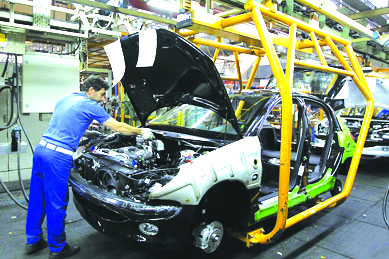December 27-2013

Lifts sanctions on auto parts, but not payments
The brief phrase in the nuclear agreement that will lift sanctions on sales of automotive parts to Iran may be what Iran is looking to in an effort to jump-start the economy.
Some analysts think this provision will put hundreds of thousands of laid-off workers back on the job and start the economic wheels spinning again across Iran, where the auto industry is the biggest industry and the key to the economy, much as the US auto industry was a half century ago. More auto sales mean more sales of glass, steel, aluminum and even fabric. It means jobs in all sorts of industries that make components for cars, everything from cylinder heads to rearview mirrors.
But others say the banking restrictions, which will remain in place, will stymie any re-start. Furthermore, the agreement is only short-term and will die if no permanent settlement is reached, so that foreign auto firms may not want to make the required investment for something that may grind to a halt very soon.
Iran’s auto industry likes to claim that it can design and make everything needed for a car inside Iran. And, indeed, many parts are made inside Iran. But not everything. When sanctions cut off Iran’s access to foreign firms—chiefly France’s Renault and Peugeot—Iran’s auto industry stumbled and went into a steep decline with output slashed by more than a third.
Investment in the auto industry “yields results fast; within a few months it can contribute to GDP growth,” Saeed Laylaz, a former economist at the Ministry of Industries and Mines, told Bloomberg news.
Removing sanctions will raise the carmakers’ potential output by 20 percent if their foreign partners return to the country, and help them create 600,000 jobs, he said.
Unemployment ranked as the top political priority in a Zogby Research poll of Iranians published this month, with 29 percent of respondents saying that is their biggest concern. About a quarter of Iranians aged 15-to-29 are jobless, according to official figures, which are widely assumed to grossly understate the real extent of unemployment.
Led by Iran Khodro and SAIPA, the country’s two biggest and dominant auto firms, Iran’s car industry employed about 2 million people at its peak two years ago. It produced 1.6 million vehicles and generated about 3.5 percent of Iran’s $500 billion economy.
At Iran Khodro, production has dropped by about 30 percent as the company struggles to obtain the parts it needs, one executive told Bloomberg. It will take at least a year to return to pre-sanctions levels, he said.
Furthermore, the company will need to sign new deals with partners and be allowed to set prices freely, he said. That wasn’t allowed under President Rohani’s predecessor, Mahmud Ahmadi-nejad. His government pressured carmakers to maintain their prices even as a declining currency and the removal of energy subsidies pushed costs up, according to industry officials including Ahmad Nematbakhsh, the secretary of the Car Manufacturers Association. The companies piled up debts to banks and suppliers.
Prices surged as governmental controls loosened, and a typical car now costs more than twice as much as two years ago, according to Laylaz.
The manufacturers can’t cut prices in the near term, and may even need to raise them, the Iran Khodro executive said. That may clash with public expectations, because Iranians expect prices to drop as a result of the sanctions deal, and could postpone buying cars until they see that happen, Donya-e Eqtesad newspaper reported.
There are signs of sluggishness elsewhere in the economy.
“Business isn’t as good” since the Geneva deal, shop-owner Javad told Bloomberg in an interview last week at his store selling bags and shoes in the Tajrish Bazaar in northern Tehran. “People think, ‘Sanctions will be lifted. Prices must come down. Why not wait?’”
Reza, a salesman at a leather-goods shop near Haft Tir Square in downtown Tehran, reached the same conclusion. “People seem lost,” he said. “They don’t know if the dollar will come down, if prices will decrease. It’s a wait-and-see situation.”
He said his own business is caught in the same dilemma. “We don’t know whether we should buy leather to make new products for the Iranian New Year,” or wait for prices to drop.
It’s unknown how long the wait-and-see will last.
Over in France, Renault itself is waiting for “clarifications” on the new sanctions regime, expected next month, before restarting sales of car parts to Iran, said Gilles Normand, head of the Asia-Pacific region at the carmaker.
He said curbs on financial transactions, which remain in place under the Geneva deal, would also need to be eased for full business to resume.
Renault has a joint venture in Iran with partners including Iran Khodro and SAIPA, and sold more than 100,000 vehicles there in 2012. As well as producing cars in Iran, it also sent kits to Iran for assembly, before halting that trade in June because of the sanctions, Normand said.
Iran Khodro, which also makes versions of Peugeot’s 206 and 405 models, is urging its partners to resume business. The nuclear deal represents a “good opportunity,” Managing Director Hashem Yeke Zare told the Tehran conference. “Those who were here before and were absent for a while, and others, we welcome them all.”
But Peugeot stopped sending its kits to Iran in January 2012, long before the harsh sanctions took hold in July. It stopped sending the kits because banking restrictions meant its Iranian partners couldn’t pay Peugeot. And those restrictions won’t change under the six-month interim deal with Iran. And Renault says it has about a quarter billion dollars of its money locked up inside Iran because of the banking restrictions.
Apart from the banking problem, the carmakers are eager to return to Iran. The European car market is stagnant and the firms have to find sales elsewhere in the world to stay afloat. Both companies are losing money right now.